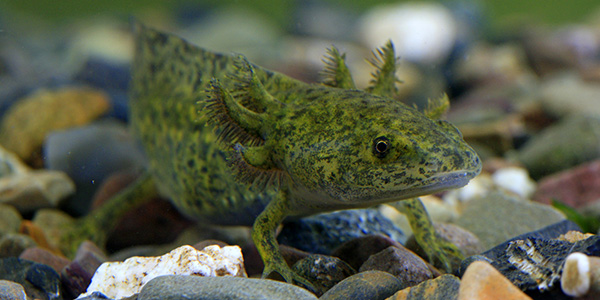“Their blind gaze, the diminutive gold disc without expression and nonetheless terribly shining, went through me like a message: “Save us, save us.” I caught myself mumbling words of advice, conveying childish hopes. They continued to look at me, immobile; from time to time the rosy branches of the gills stiffened. In that instant I felt a muted pain; perhaps they were seeing me, attracting my strength to penetrate into the impenetrable thing of their lives. They were not human beings, but I had found in no animal such a profound relation with myself. The axolotls were like witnesses of something, and at time like horrible judges.”
-Julio Cortázar, Axolotl
I want to talk to you about axolotls, but in a way I can’t. They have to be seen. I’ve only seen one in my life, at an aquarium 2,831 miles away from their ancestral home at Lake Xochimilco in Central Mexico. There is one other lake where axolotls once lived, Lake Chalco, but it no longer exists. I’ll get to that soon.
There’s something in the face of an axolotl that is blessedly human – or, perhaps, there is something in the face of human beings that reflects the beauty of axolotls. Their neotonic bodies and knowing expressions transcend any notion of age or era. Ominously primordial, with their slow gait and mournful gaze, axolotls feel less like animals and more like manifestations of the Earth itself, incarnations of the rivers and lakes of their perpetual youth.
I first learned of them through Julio Cortazar’s story quoted above. I encourage everyone I know to read it. It’s a beautiful piece, full of incredible prose and disquieting sensuality. It’s also a requiem for these little salamanders. Even in Cortazar’s time they were dying, being found more in aquariums and fish tanks than the bodies of water where they had lived for millennia. The ancient lake Chalco, once the center of early Mesoamerican culture, is gone now, drained to prevent flooding in new housing and business developments. Xochimilco is a shadow of its former self, existing mostly as canals and shallow, oil-slicked pools. Pollution, urban sprawl, and encroaching industrial development will rid the world of wild axolotls soon. Look into the face of an axolotl. It carries the judgment that we deserve.
In Nahuatl, the intricate and beautiful language of indigenous central Mexicans, axolotl means “river monster.” And now the Nahua people are being slaughtered, exported as modern-day slaves and driven off their land. The axolotl is dying with them.

